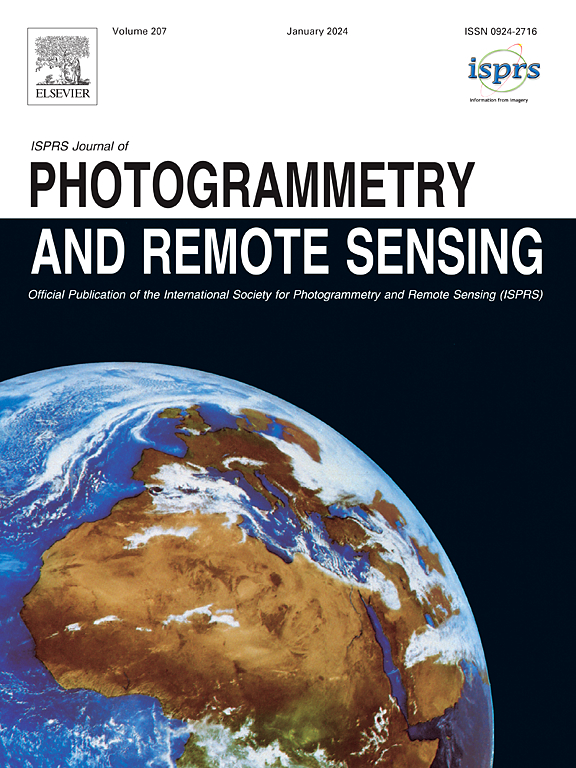GAT-LSTM:动态环境下基于特征的视觉SLAM特征点管理网络
IF 10.6
1区 地球科学
Q1 GEOGRAPHY, PHYSICAL
ISPRS Journal of Photogrammetry and Remote Sensing
Pub Date : 2025-04-09
DOI:10.1016/j.isprsjprs.2025.03.011
引用次数: 0
摘要
视觉同步定位与映射(vSLAM)在从机器人到增强现实的各种应用中都至关重要。然而,动态环境给 vSLAM 带来了困难,因为它通常依赖于提取的特征点(FPs)。在动态环境中有效管理 FPs 是一项重大挑战。为了应对这一挑战,我们提出了一种创新解决方案,利用集成到长短期记忆(LSTM)网络中的图注意力网络(GAT),使系统能够优先关注这些稳定的 FP。GAT 组件从作为图节点的单个图像 FP 中提取空间结构信息,从而为每个 FP 的局部关系建模。同时,LSTM 模块有助于对局部关联进行一致的时间特征分析。我们的方法有效地融合了局部关系建模和全局一致性分析,首次将 GAT-LSTM 应用于解决动态和错误跟踪 FP 带来的复杂问题。此外,我们还引入了反向传播外极几何求解器,以解决深度神经网络中这一不可反向传播的优化模块。此外,单目 vSLAM 无法直接测量距离,通常依赖于参考物体或运动信息。由于纹理缺陷和运动模糊,深度估计既复杂又容易出错。因此,我们提出了一种密集深度估计方法,利用选定的稳定 FP 和深度估计网络来减轻深度估计带来的挑战。我们利用 KITTI、VIODE 和内部数据集,在纯视觉里程计 (VO) 框架和视觉惯性里程计 (VIO) 中验证了 GAT-LSTM 网络。这些实验表明,使用 GAT-LSTM 排除动态和误差跟踪 FP 可显著提高里程测量的准确性和鲁棒性。与现有方法相比,VO 的绝对姿态误差均方根误差降低了 4.52%-76.86% ,VIO 的绝对姿态误差均方根误差降低了 9.09%-96.94% 。我们的实践为更稳健、更精确的 vSLAM 及其他相关领域提供了宝贵的见解和潜在应用,凸显了 GAT 和 LSTM 网络集成的优势。本文章由计算机程序翻译,如有差异,请以英文原文为准。
GAT-LSTM: A feature point management network with graph attention for feature-based visual SLAM in dynamic environments
Visual simultaneous localization and mapping (vSLAM) is crucial in various applications, ranging from robotics to augmented reality. However, dynamic environments cause difficulty to vSLAM, which often relies on extracted feature points (FPs). Effectively managing FPs in dynamic environments poses a significant challenge. To address this challenge, we propose an innovative solution that leverages a graph attention network (GAT) integrated into a long- short-term memory (LSTM) network, enabling the system to prioritize attention on these stable FPs. The GAT component extracts spatial structural information from individual image FPs, which are graph nodes, thereby modeling the local relationship of each FP. Meanwhile, the LSTM module facilitates the local association’s consistent temporal feature analysis. Our approach effectively blends local relationship modeling with global consistency analysis, presenting the first application of GAT-LSTM to tackle the complexities introduced by dynamic and error-tracking FPs. Additionally, we introduce a backpropagating epipolar geometry solver to address this non-back propagatable optimization module in a deep neural network. Moreover, monocular vSLAM cannot directly measure distances and typically depends on reference objects or motion information. Depth estimation is complex and error-prone due to texture deficiency and motion blur. Thus, we present a dense depth estimation approach to mitigate the challenges associated with depth estimation by leveraging the selected stable FPs and a depth estimation network. We validated the GAT-LSTM network within a purely Visual Odometry (VO) framework and a Visual-Inertial Odometer (VIO) using the KITTI, VIODE, and in-house datasets. These experiments demonstrated that the exclusion of dynamic and error-tracking FPs using GAT-LSTM significantly enhances odometry accuracy and robustness. Compared to existing methods, the root-mean-square error of absolute pose error decreased by 4.52%–76.86% in VO and by 9.09%–96.94% in VIO. Our practice offers valuable insights and potential applications for more robust and accurate vSLAM and other related fields, highlighting the benefits of integrating GAT and LSTM networks.
求助全文
通过发布文献求助,成功后即可免费获取论文全文。
去求助
来源期刊

ISPRS Journal of Photogrammetry and Remote Sensing
工程技术-成像科学与照相技术
CiteScore
21.00
自引率
6.30%
发文量
273
审稿时长
40 days
期刊介绍:
The ISPRS Journal of Photogrammetry and Remote Sensing (P&RS) serves as the official journal of the International Society for Photogrammetry and Remote Sensing (ISPRS). It acts as a platform for scientists and professionals worldwide who are involved in various disciplines that utilize photogrammetry, remote sensing, spatial information systems, computer vision, and related fields. The journal aims to facilitate communication and dissemination of advancements in these disciplines, while also acting as a comprehensive source of reference and archive.
P&RS endeavors to publish high-quality, peer-reviewed research papers that are preferably original and have not been published before. These papers can cover scientific/research, technological development, or application/practical aspects. Additionally, the journal welcomes papers that are based on presentations from ISPRS meetings, as long as they are considered significant contributions to the aforementioned fields.
In particular, P&RS encourages the submission of papers that are of broad scientific interest, showcase innovative applications (especially in emerging fields), have an interdisciplinary focus, discuss topics that have received limited attention in P&RS or related journals, or explore new directions in scientific or professional realms. It is preferred that theoretical papers include practical applications, while papers focusing on systems and applications should include a theoretical background.
 求助内容:
求助内容: 应助结果提醒方式:
应助结果提醒方式:


